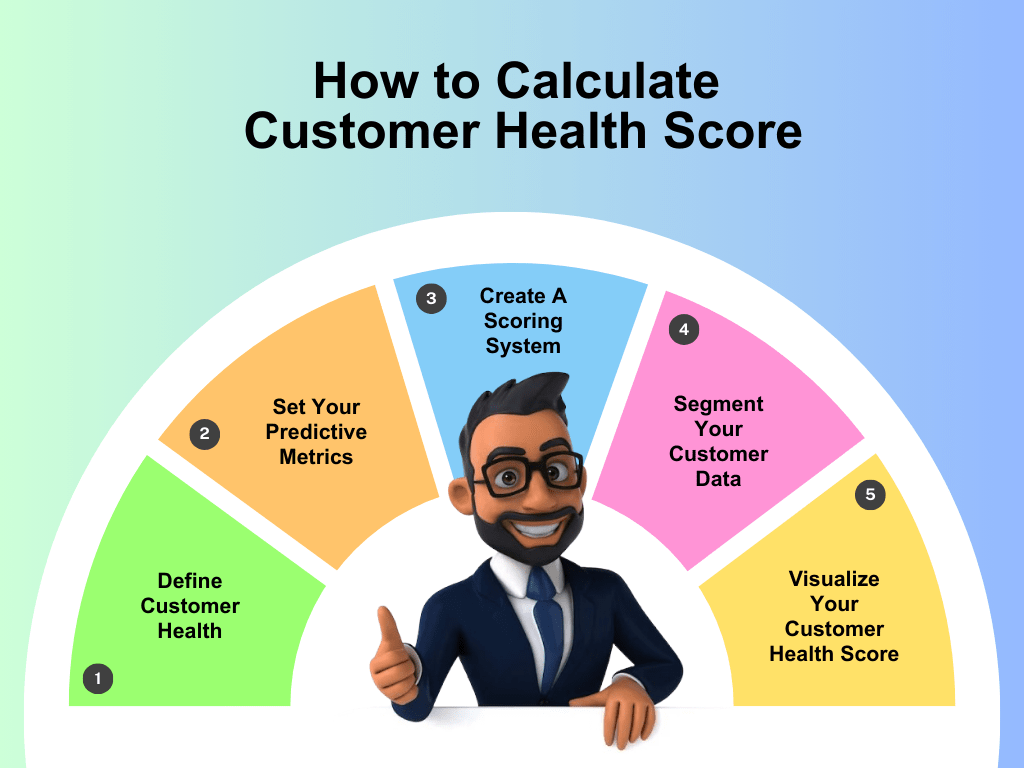
What is Customer Health Score? Learn How to Measure It
By Uttam Kumar Dash
December 26, 2023
Last Modified: November 28, 2024
Have you ever wondered how businesses predict whether one will stick around as a customer or consider parting ways? That’s where ‘Customer Health Score’ comes in.
It’s like a compass for your relationship with a brand. Let’s dig in to see how it assists businesses in retaining their customers.
What is Customer Health Score?
The customer health score measures how happy and involved customers are with a company. It gives a good idea of whether a customer will stick around or not. This score is determined by factors such as product usage, customer feedback, and interaction frequency with the company.
The higher the score, the better. Customers with high scores are happy and involved—they buy regularly and even bring in new customers.
But if the score is low, it’s a sign that customers might be losing interest and could leave. This could happen if the company isn’t keeping up with what the customers need.
It helps you measure the overall well-being of your customer relationships.
Note: The metric is mostly useful for software companies, customer service teams, marketers, and account managers to ensure customer success. This enables you to proactively prevent churn of your customer base.
Importance of Customer Health Score
Healthy customers tend to stay, while unhealthy ones might leave. Creating a scoring system helps spot potential issues early.
Imagine a scenario: A customer’s score drops below a set level. That’s your cue to reach out, address concerns, and prevent them from leaving.
Use this system to flag customers at risk. Make sure to understand their needs, and keep them satisfied. It’s like a cheat code for customer happiness.
On the bright side, high scores highlight your biggest fans. Harness their positivity by encouraging reviews and turning them into advocates for your business.
“The Customer Health Score is used by 42% of marketers to measure client success.”
Source: Regalix
Wondering where to start? Let’s break down the steps to measure customer health at your company.
How to measure customer health – Calculate now!
Customer Health Scores differ across industries. It is often a proprietary formula. Therefore, how you calculate them depends on the customer behavior metrics you find most important for your business. However, a basic representation would look like this:

Step 1. Define your customer health goals and purpose for the score.
2. Choose predictive behavior metrics aligned with your objectives.
3. Establish a scoring system based on chosen metrics.
4. Segment customer data into categories for analysis.
5. Visualize the customer health score for easy team comprehension.
A basic equation for a Customer Health Score is:
Customer Health Score (CHS) = ( W1 × Metric1 ) + ( W2 × Metric2 ) +…+ ( Wn × Metricn )
- Metrics (e.g., Product Usage, Customer Feedback) have assigned weights.
- Weights show how important each metric is (%).
- Combined, they decide the overall health of the customer relationship.
7 metrics to measure customer health
- Product usage: Monitor how customers use your products or services to understand their effectiveness and frequency.
- Customer feedback: Gather insights from customer surveys, reviews, and feedback to comprehend their sentiments and opinions.
- Marketing engagement: Assess the level of customer interaction with marketing campaigns, emails, and promotions.
- Website activity: Analyze customer behavior on the company website. It includes page views, time spent, and interactions.
- Customer support cases: Track customer support inquiries, including the number and resolution times, to measure satisfaction.
- Product upgrades and renewals: Monitor the adoption of new features, upgrades, and the renewal status of subscriptions or services.
- Community participation: Evaluate the degree of involvement in community forums, discussions, or events related to the brand.
According to a report by CSM Practice, “Usage, and engagement are 2X more likely to be used in assessing a customer’s health than ROI and use of resources.”
Let’s solve a math problem for clarity
Calculate the total Customer Health Score for the following companies:
The provided weights for Product Usage are 35%, Customer Support 30%, Customer Sentiment 25%, and Customer Advocacy 10%.
| Account | Annual Recurring Revenue (ARR) in ($) | Product Usage (35%) | Customer Support (30%) | Customer Sentiment (25%) | Customer Advocacy (10%) |
| Quantum Innovations Corp. | $75,000 | 7.6 | 5.0 | 3 | 6.0 |
| Nebula Dynamics Ltd. | $115,000 | 9.1 | 1.0 | 10 | 6.0 |
| Techno Nexus Solutions | $134,000 | 0.0 | 6.0 | 10 | 10.0 |
| Swift Logistics Express | $5,000 | 0.0 | 10.0 | 1 | 5.0 |
| BioGenix Solutions Inc. | $295,000 | 9.7 | 6.0 | 0 | 0.0 |
Using the provided equation, weights, and metrics scores the answer can be determined as follows:
- Quantum Innovations Corp: (0.35 × 7.6) + (0.30 × 5.0) + (0.25 × 3) + (0.10 × 6.0) = 5.51
- Nebula Dynamics Ltd: (0.35 × 9.1) + (0.30 × 1.0) + (0.25 × 10) + (0.10 × 6.0) = 6.585
- Techno Nexus Solutions: (0.35 × 0.0) + (0.30 × 6.0) + (0.25 × 10) + (0.10 × 10.0) = 5.3
- Swift Logistics Express: (0.35 × 0.0) + (0.30 × 10.0) + (0.25 × 1) + (0.10 × 5.0) = 3.75
- BioGenix Solutions Inc.: (0.35 × 9.7) + (0.30 × 6.0) + (0.25 × 0) + (0.10 × 0.0)= 5.195
So, out of 10, the Customer Health Scores for these companies are approx. 5.5, 6.6, 5.3, 3.8, and 5.2.
Customer Health Score examples
Customer health scores can be shown in many ways. Check out these examples to get a clear picture.
1. Alphabetical scale
An alphabetical scale assigns a letter to customers based on their health score, akin to a grading system. The higher the score, the higher the grade.
2. Percentage scale
Scores in this system are category-based, not a simple average. Each category holds a specific value. These allow important events to weigh more than minor events, like a product upgrade influencing the percentage scale.
3. Ranking scale
4. Color code scale
Similar to the alphabetical scale, the color code scale simplifies interpretation for quick responses in customer service. Colors are assigned based on a predefined scale. Typically, green indicates a healthy customer, yellow for moderate, and red for those requiring attention.
Happy customers mean a healthy business

“I recommend that CS leaders increase their investment in their development and maintenance of health scores. A true health score should be a representation of the customer’s sentiment. That sentiment is formed by all touchpoints with the vendor, not just those with the Customer Success organization. Be serious about health scores by assigning responsibility to people who have experience of working with data and customers.”
Peter Armaly
Senior Director of Customer Success
at Oracle
Maintaining high customer health scores goes hand-in-hand with delivering exceptional service. After all, happy customers mean a healthy business.
Thank you for your time! We hope you’ve gained valuable insights or found something intriguing here that adds value to your curiosity.
Start off with a powerful ticketing system that delivers smooth collaboration right out of the box.
















Leave a Reply